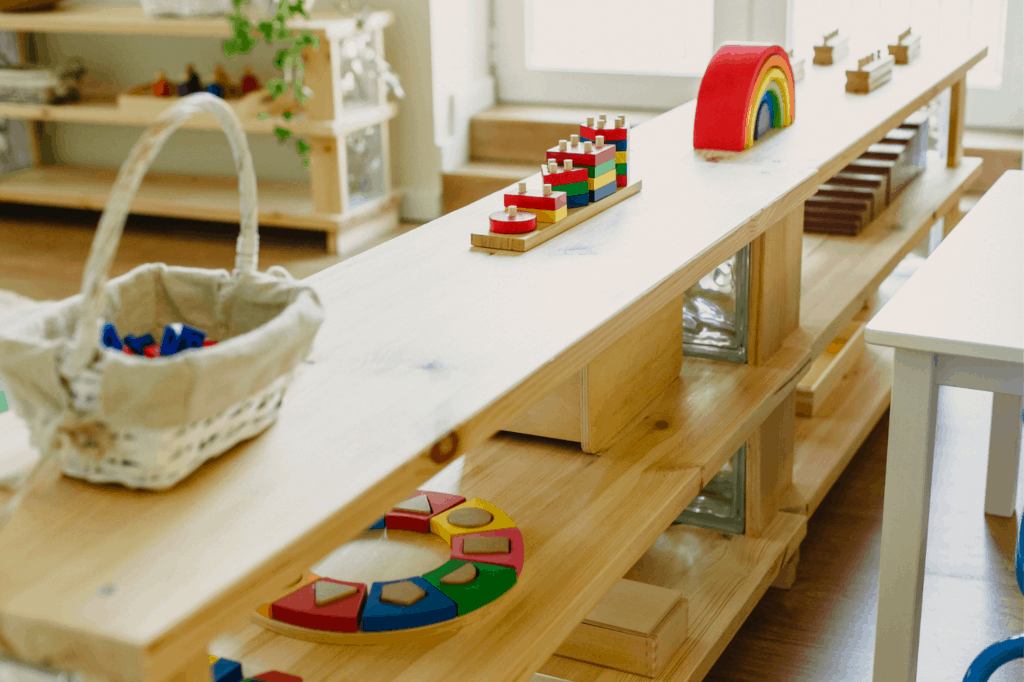Doctor Maria
Grace and Courtesy is the term used to refer to the idea of teaching children to be a polite member of society and conduct themselves properly in social situations. Grace and Courtesy is one of the foundations of the Montessori method and is applicable both in the classroom and in everyday life.
Grace and courtesy are taught to all age levels and are presented in different ways, depending on the child’s stage of maturity, and on whether the lessons are happening in the classroom or the home.
Grace and Courtesy as a Key Part of Montessori Education
Yvonne Froelich, an elementary guide for the
Her suggestions for incorporating grace and courtesy into both academic and domestic settings revolve around teaching the same basic concepts. These concepts include lessons on greeting each other, participating in conversations by actively listening without interrupting, resolving conflicts, and following directions.
What are Grace and Courtesy?
In his study on the role of grace and courtesy, Pat Ludick defines grace as “the manner in which we value ourselves.” It is an intrinsic quality of a person, which describes how self-esteem plays into selfless behavior (i.e., relating how one treats others to how they are treated in return and from there how they feel about themselves).
Courtesy, then, is how one offers grace to other people. Ludick defines courtesy as “the manner in which we respect the beings of others.” This aspect of
The two ideas of “grace” and “courtesy” are reliant on each other, and so are taught simultaneously. The child learns what to do and why to do it at the same time. Peaceful Pathways Montessori Academy describes grace and courtesy as “the language of respect [and] kindness,” as well as the social etiquette we need in everyday society.
These concepts of helpfulness and contribution are the keys that
When to Begin Teaching Grace and Courtesy
While Grace and Courtesy teaching begins in
The Planes of Development and Their Role in Teaching Grace and Courtesy
Montessori functions at a basic level on a system of stages for different age ranges that defines the developmental milestones to be focused on and achieved at each stage. These are known as the four Planes of Development. The concepts of grace and courtesy are built into the lessons that form the focus of these planes and help to establish a solid groundwork for a well-adjusted, kind, and courteous adult.
- Early Childhood
This first plane of development, also known as the absorbent mind, lasts from birth up to the age of six. In this plane, children are learning basic self-sufficiency by way of movement, language, and basic life skills, such as learning to clean up after themselves and to use the restroom. The focus of teaching at this age is on establishing a child’s personality, as well as their physical independence and academic curiosity.
- Childhood
The second plane of development covers ages six to twelve. This plane’s focus is on intellectual independence, which is the ability to think and reason for oneself, and the curation of morality. Childhood is the time in which a child’s personality becomes much clearer, and they develop social relationships with each other and with their teachers and other adults. Lessons at this age focus on discerning right from wrong, fairness, and a child’s place in society and the world as a whole.
- Adolescence
The third plane of development covers ages twelve to eighteen. It dials in on developing emotional independence, or the ability to reconcile one’s emotions with their actions as well as building self-confidence and self-esteem. Education at this stage is given a higher level of self-direction, with the students choosing what lessons they believe they need to succeed later in life with minimal guidance provided upon request from their teachers. This plane’s lessons focus on establishing an adolescent’s sense of social self and control by encouraging self-governing.
- Maturity
The last plane of development covers young adulthood, from ages eighteen to twenty-four. It is usually during this stage that teachers and other adults will take a significant step back from the now young adult, recognizing that they are now at a point in which they need to integrate themselves into the wider world. In this plane, young adults aim to achieve financial independence and self-sufficiency. Any lessons given at this point are to help the young adult achieve a level of spiritual self-realization and deeper self-understanding, as well as practical life skills not already established.
For a more in-depth explanation of each plane of development, you can read this article from Silverline Montessori. It is best to start your children’s education in grace and courtesy as soon as possible so that they are able to build on the lessons they receive as they grow.
Lessons for Different Ages in Grace and Courtesy
Based on the planes of development, lessons in grace and courtesy are easily adaptable for children as they grow and mature. While there is no set curriculum for
Lessons for Young Children
Basic lessons for the youngest of children focus on learning to manage the self. They generally begin by teaching self-reliant behaviors, such as toilet training, eating meals, and cleaning up after oneself, as well as establishing when and where certain behaviors are appropriate. Children of this age need someone to tell them the importance of their actions and their timing for their own wellbeing, as that is their main priority. Still, they will also want to please others and, therefore, will emulate behaviors that they see bring joy to their role models, for instance, teachers and parents.
Lessons during this time can cover:
- Love and respect
- Responsibility for one’s possessions
- Learning to maintain hygiene
- Learning to greet others and how to say goodbye
Lessons for Older Children
As the children grow into the second plane of development, the focus of their education shifts to extending that management of themselves to managing their developing relationships with others. Their phrasing in this stage can seem rude or abrupt when it is, in fact, merely uneducated. Children in this stage of learning are developing their place in groups and broader society and learning the impact of their actions on others.
The important lessons of this phase are how to interact with others socially, such as how to contribute by doing basic chores like sweeping or picking up toys, and how to greet and play with other children. Through these basic life skills, children learn to think of others before themselves, and to act in a way that helps them.
Lessons during this time can cover:
- Learning to hold a conversation with a friend
- Waiting for one’s turn
- Asking questions and giving answers
- How to treat a guest
Lessons for Adolescents
In the third phase of development, from twelve years old into adolescence, children begin assembling their fundamental moral compass. The lessons in this stage are things like technological savviness, civic duty, and the taking on of responsibilities like driving and their own bank accounts.
Lessons for this age group are focused on direct consequences and personal relationships to them, asking the adolescent to identify those consequences and their causes for themselves so that they can resolve them themselves. This phase is full of insecurities, where the adolescent is safely working through them before becoming part of the adult world.
Lessons during this time can cover:
- How to hold a conversation about a sensitive topic
- How to address a mistake and reconcile it
- Expressing an opinion confidently
- Overcoming negative comments and peer pressure
Lessons for Young Adults
Even after they reach legal adulthood, young adults from a background of
These final lessons focus on curating the grace and courtesy established in childhood into active parts of an adult’s personality. They are asked to be mindful of their relationship with themselves, their communities, and society as a larger whole, and make thoughtful decisions that benefit all involved.
Lessons during this time can cover:
- How to appropriately leave a workplace
- How to interact appropriately in a romantic setting
- Participating actively in your local and national governments
- Offering your services to community improvement programs
How Grace and Courtesy is Taught in Schools
Montessori schools operate on a system of classrooms of mixed age ranges that run on a schedule of blocks of uninterrupted work time, in which the children choose their activities at their own pace.
Basic Grace and Courtesy Incorporation
This element of choice is structured by the availability of activities that the student can interact with on their own when they want to learn about that topic. The teachers will work with them on particular lessons, such as guiding them through academic skills like reading, math, and science. They will also guide them through
Because of this, teaching grace and courtesy is incorporated into many different elements of learning. Grace and courtesy can be found primarily in practical life activities in the classroom. They are starting with concepts as simple as learning to put away their activity when they are done, so that another student can use it, or helping to set and clear the table for lunch.
By allowing the children to choose how they participate,
Modeling Appropriate Behaviors
Channeling the idea of the absorbent mind, teachers explain grace and courtesy to young children through modeling: the process of behaving in front of children how you want them to behave. Teachers will model behaviors their students should replicate, being careful to perform kind acts like opening the door for someone or sharing their things. They greet each child individually by name, and they are calm and patient when speaking to the children and each other.
They will also take into consideration criticisms brought to them by the children on older planes of development. When a child asks them about specific behaviors and the teacher reflects on the action and corrects their behavior, the child learns that not only are criticisms essential and constructive, but they are allowed to be wrong and accept correction without being in trouble.
Role-playing can be an incredibly useful tool in teaching grace and courtesy. By using dolls or other toys that children are excited by to model behaviors they want to see replicated, teachers are developing a positive association with the behavior. This also encourages students to make grace and courtesy part of their playtime; they may repeat the role-play scenario shown to them by the teacher when they are playing with those some toys. Later, this translates into emulating those behaviors when children are playing together.
Conflict Resolution
Children at this age begin to learn the basic strategies of conflict resolution with their peers. As explained by Annie Green, a Primary teacher for the
This means that the teacher’s goal is to ensure that the children are equipped with the language they need to talk appropriately about their emotions and come to adequate resolutions for small disagreements. Through direct conversation by guiding a child, explaining what they are feeling and why, and then guiding conversations between children so that they both understand what needs to be done, everyone is satisfied with the results.
Self-Moderation and Reflection
In older classrooms, Socratic meetings are an important part of teaching grace and courtesy, allowing the children to moderate themselves and learn from others’ ideas. In essence, a Socratic meeting is designed to produce “productive discomfort,” or to introduce ideas that challenge a student’s worldview in a way that allows them to expand or improve it without feeling overwhelmed or defensive.
Generally, a Socratic meeting will be a group of students sitting together, usually in a circle, discussing topics and issues in a calm debate style. They are encouraged to bring up their own points of conversation, as well as to build on the points presented to them by their classmates. In other words, teachers passively teach the children to learn in their own way, not only from their teachers but from each other.
In all age ranges, a common tool used in schools is the keeping of a journal. Writing daily journal entries about their day and the struggles they faced as well as how they resolved those struggles is an exercise in self-reflection. Teachers will encourage students to write entries during class time, asking them to reflect on specific situations or ideas, such as “what am I grateful for today?” or “what have I done to help others today?” They may also encourage them to write about a particular event or conversation they had and what they may do to handle similar situations better in the future.
How to Teach Grace and Courtesy at Home
Montessori education is just as important in the home as it is in a school environment. To properly achieve the milestones of the first stage of development, parents should try to implement the tactics and behaviors used by teachers and guides in schools. First and foremost, you should be observing your child and learning from them what they already know and what they need to improve on. Your focus should be on a positive, constructive representation that allows the children to learn the lessons without having to force them.
Teaching Grace and Courtesy to Younger Children
Children younger than three are incredible learners and will pick up on parental teaching quickly, laying a solid base of knowledge for their teachers to build on later.
As mentioned above, an excellent method of developing grace and courtesy in your child is to use modeling techniques. Behave in the way that you want your child to behave. You can also use humor as a tactic to exemplify inappropriate behaviors and encourage your child to offer suggestions for correcting your actions. You should interact on the same level as your child, kneeling or sitting so that you can look them in the eye as you talk and provide examples, showing them the same level of respect that you want them to show you.
In the Xavier University podcast mentioned earlier, Froelich suggests giving children direct responsibilities in the form of chores, such as asking your child to help you with the laundry or the gardening, and explaining how these actions help not only the child but others in the home. It also helps if the child has tools that are their size as well, including smaller brooms and dustpans, so that they can help with more ease and independent action. This helps them achieve grace in a sense of belonging and usefulness, as well as understanding the courtesy of helping to contribute to the home.
Teaching Grace and Courtesy to Older Children
For older children, it’s important to honor opinions and discuss them so that your child feels heard, valued, and understood. Family dinners are an excellent place to practice this in a comfortable, safe setting. Parents should be available to listen to their children, and should ask them what they want from that interaction: are they a sounding board, a source of advice, or is the child asking them to fix the situation? Again,
As another aspect developing grace in your child through a sense of self-worth, parents should make an active effort to participate in their child’s life outside of the home. Attend parent-teacher conferences with the child present so that they can weigh in on their teacher’s comments, or if this isn’t possible, discuss these meetings afterward in the home.
Encourage your child to take part in extracurricular activities that interest them and to keep their own schedule for those activities while discussing with your how they intend to keep it. That level of control can help develop a child’s sense of social responsibility.
For more on how to engage your child with
The Challenging of Assumptions in Teaching Grace and Courtesy
All education comes with its challenges and difficulties, and
Most adults grew up with parents who raised them in a way that meant they were to listen to adults without question and obey commands given to them quickly with just as little curiosity. This, then, becomes how they approach their children and what they expect from them. While this is not an entirely wrong way to raise a child, it does mean that they are not as quick to absorb information and natural lessons in practicality. It also diminishes the importance of independent learning. This set of expectations is contrary to
To combat this,
The Bigger Picture of Grace and Courtesy in Montessori Education
Montessori educators use Grace and courtesy as a cornerstone from which children can grow up fulfilled, practical adults that are fully capable of taking care of their own needs, as well as the needs of their communities at the local, national, and global levels. They provide a framework for morality and conscientious action, which then translates into how those adults raise their children.
The goal of grace and courtesy in







